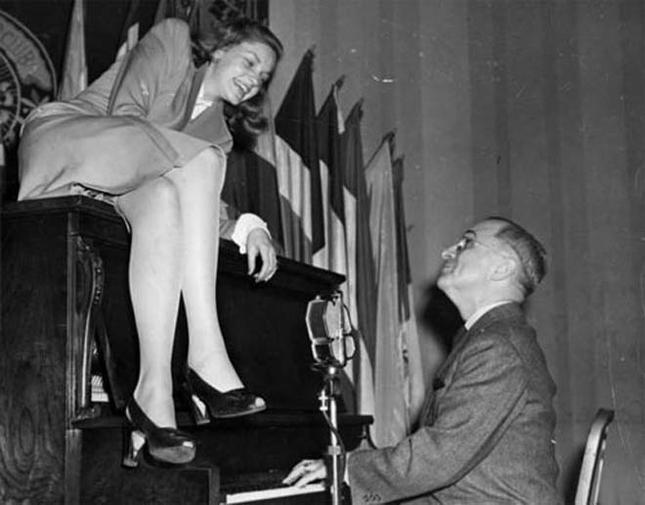American Gal: This Long-Lived Lauren Was a Real Betty
By • September 10, 2014 0 1026

If cats have nine lives—and there was always something feline about her–Lauren Bacall had at least several in her life of legend.
Chapters in her early years can be boiled down to: before Bogey, with Bogey and right after Bogey. The rest involved a dwindling movie career, a resoundingly spectacular Broadway stage career with a cluster of roles that gave her diva status and a stately, always long-legged, glide into legend, an idea which she didn’t much cotton to.
As there always is, there was the last act, her death: at age 89 of a stroke Aug. 12 at the Dakota on the Upper West Side of New York City, where she lived for many years. It resurrected all in all of the venues of communications that comprise the forever industry and followed on the heels of the horribly sad loss of Robin Williams, who took his own life.
Hers was quite a life, if not quite a wonderful life, seeing as she began as a nice Jewish girl, named Betty Joan Perske. The name Lauren was chosen for her by director Howard Hawks—a man’s man director if there ever was one—who thought it sounded classy. She was not one of those stars who necessarily answered to her movie star name—she always preferred to be called Betty by her friends.
Hawks saw a 1943 cover that she did as a teen model in Harper’s Bazaar, all smoke and mirrors and sultry, and cast her in “To Have and Have Not,” a Warner Brothers classic tough-guy hero picture based on a novel by Ernest Hemingway, the ultimate tough guy writer, until Norman Mailer came along, and starring the premier Hollywood and American tough guy of deep cynicism and wise cracks, Humphrey Bogart. Into this booze-scented mélange of testosterone walked (and slithered and shimmied and even sang) Lauren/Betty, all of 19 years old, and Bogart—just watch the scenes sometime—looked like the 45-year-old-guy who’s forgotten how old he is. It didn’t happen in a second, but it was pretty fast for a time that didn’t have speed dating.
Bacall and Bogart made four movies together—“To Have and Have Not,” “The Big Sleep,” “Key Largo” and “Dark Passage,” the first three classics of the Hollywood black-and-white golden age of noir.
Bacall may have been 19 years old, and in youth astonishingly beautiful, but she looked and acted like an adult. She was in your face and imagination and mind even (and one time, especially, when she was walking away.) Movie buffs know all the lines from that movie (“To Have and Have Not”) and moments—she’s seen in a doorway, kind of posing, pulls out a cigarette and asks, “Anybody got a light?” Bogey, after some thought, throws her a book of matches, which she catches like a slick con woman. She lights up, starts to walk, turns around and says, “Thanks.” This single word hit Bogey like a paragraph. Or “You know how To whistle, don’t you? You just put your lips together and blow.” Or after a kiss, “It’s even better when you help,” and after yet another kiss, “And if you shave, maybe we could do it again.”
No wonder they got married, after so much smooching.
In the 1950s, when live drama was in vogue on television, they appeared together in a Producer’s Showcase production of “The Petrified Forest,” with Bogey, noticeably gaunt, reprising his role of the gangster Duke Mantee from the 1930s. Bacall took on the Bette Davis role, and Henry Fonda played the idealistic writer, originally performed by Leslie Howard.
Bacall said she didn’t care about the age difference and considered it a plus—she was 19, Bogey was 45, when she taught us how to whistle. It’s fair to say there were occasions of disparity and discomfort, nothing that could harm a relationship which endured mostly happy until his death from throat cancer.
Those years with Bogart spanned the last years and legends of studio-made Hollywood and made Bacall one of the last surviving members, a bigger than life figure, partly because of Bogart, and the other men in her life—an odd grouping of a caddish Frank Sinatra, a roaringly-drunk but gifted Jason Robards, and even Adlai Stevenson, the cerebral man who would be but never was president.
Her movies tended to be a uneven array—a splashy fashion romance with Gregory Peck called “Designing Woman,” a high society femme fatale who almost undoes the jazz gift of Kirk Douglas, in the China seas with John Wayne in “Blood Alley,” sparkling and outstanding alongside Marilyn Monroe and Jane Russell (she’s the thin one) in “How To Marry A Millionaire,” being stalked by Michael Biehn and loved by James Garner in “The Fan,” a widow-lady in John Wayne’s last western, “The Shootist,” and being nominated for an Oscar for Best Supporting Actress in the Barbra Streisand weeper, “The Mirror Has Two Faces,” in 1996.
Perhaps because of Robards, who was considered American theater’s most brilliant interpreter of Eugene O’Neill—and a pretty good movie actor, too—she found herself on Broadway, not with O’Neill but with lighter, diva-like fare, sharp comedies like “Goodbye Charlie” and “Cactus Flower.” To cap it all off, two Tony Awards for “Applause,” which was based on “All About Eve” (she had the Bette Davis part), and “Woman of the Year,” in which she played a woman journalist opposite Harry Guardino. It’s no surprise that the part was originated by Katharine Hepburn, or that she was a good pal of the marvelous Kate. Two of a kind, if you ask anybody.
In the end, Bacall became what she didn’t want to become: legendary, for all the right reasons, the best people and the best of times in Hollywood. Here’s looking at her, the kid.

